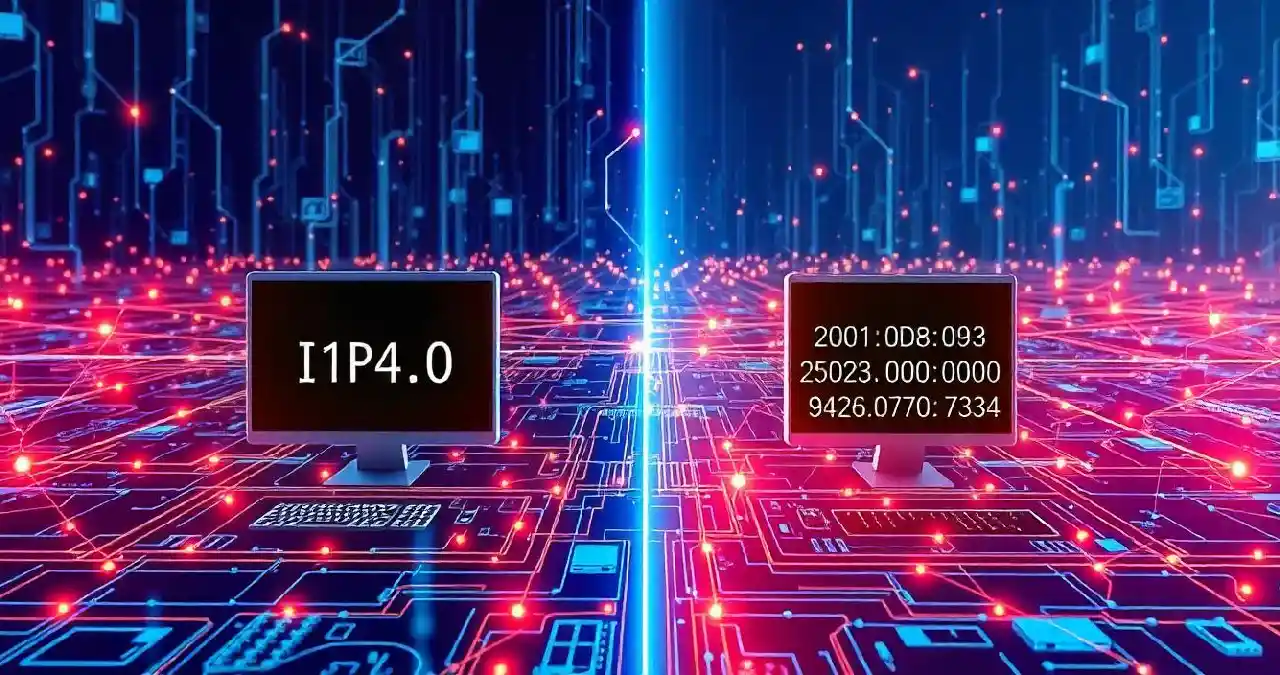The computer talks with the help of an address to another computer. This is known as Internet Protocol Address. It is briefly known as IP Address. Let us share an example. Those willing to launch a web page might also load it on their computer. The team needs a particular address to suggest a specific file. It could be a web page also. This address has been identified as an IP Address. IP represents Internet Protocol Address, an original group of numbers allotted for every gadget linked to the network and similar to the Internet.
We are getting two types of IP. The first one is old and it is IPv4. The second one is new and it is IPv6. They have different functions and characteristics. If we follow the differences carefully, we come to know the reason behind the demand for IPv6. We must remember that the internet is expanding and changing very fast.
In the article of Webtechhelp, we will discuss about the IPv4 vs IPv6.
What is IPv4? A Look Back at the Early Internet
IPv4 deals with two aspects. They are the address of the network and host. It represents Internet Protocol Version Four. DARPA had launched it in 1981. In 1982, it was initially deployed and the goal was production using SATNET. In 1983, in January, there was ARPANET. Finally, you can get the details of IPv4 vs IPv6.
IPv4 addresses, we mean integers having 32 bits. They are represented in the form of decimal. There are 4 numbers divided by dots. They have a range starting from 0 and ending in 255. They were changed to 1 and 0. Therefore, it helps the computer to understand clearly. For instance, you can write the address of IPv4 in the form of 189.123.123.90.
What is IPv6? The Next Generation of Internet Protocols
IPv6 has the grounds in IPv4. Internet Protocol Version 6 is the full form. In 1995 in December, the Internet Engineering Task Force launched it. The internet protocol has a new mode and it is IP version 6. It is better than IP version 4 because of the speed and complication. You can write IPv6 in the form of a set of eight numbers which are hexadecimal in type. Colon (:) separates them. You will be able to write 1s and 0s in the form of 128 bits. So, you can get an idea of IPv4 vs IPv6.
IPv4 vs IPv6: A Side-by-Side Comparison
The comparison of IPv4 vs IPv6 has been described below:
| IPv4 | IPv6 |
| The length of the address of IPv4 is 32-bit. | The length of the address of IPv6 is 128 bits. |
| This assists in DHCP and the configuration of addresses by hand. | This assists in the configuration of addresses in renumbering and auto mode. |
| For end-to-end IPv4, we are unable to fulfil the integrity of the connection. | For end-to-end IPv6, we can obtain the integrity of the connection. |
| The address space of IPv4 is 4.29×10 9. | In the case of IPv6, the address space is 3.4×10 38, which is big. |
| The feature of the security in IPv4 is connected with the application. | In the case of IPv6, IPSEC represents the feature of inbuilt security. |
| The decimal is used to represent the address of IPv4. | Hexadecimal is used to represent the address of IPv6. |
| Forwarding routers as well as the sender carry out the fragmentation. | The sender carries out fragmentation only. |
| The isolation of packet flow could not be found. | The isolation of packet flow is present and the header shows the field of flow label. |
| We find the checksum field. | We do not find a checksum field here. |
| The message transmission scheme shows broadcasting. | The message transmission schemes are anycast and multicast. |
| We do not get the benefit of authentication and encryption. | An individual gets the benefit of authentication and encryption in IPv6. |
| The value of the header varies between 20 to 60 bytes. | There is a fixed value for the header and it is 40 bytes. |
| We can change IPv4 to IPv6. | Most of the IPv6 could not be changed to IPv4. |
| There are four divisions of IPv4 and they are compartmentalized by a dot (.). | There are eight areas of IPv6. They are removed from one another using a colon (:). |
| An individual can get five addresses of classes in IPv4. The first one is class A, the second one is class B, the third one is class C, the fourth one is class D and the fifth one is class E. | There are no classes in the IP address of IPv6. |
| VLSM is Variable Length Sublet Mask and IPv4 assists it. | VLSM is not present in IPv6. |
| IPv3 example is 66.94.29.13. | An example is 2001:0000:3238:DFE1:0063:0000:0000:FEFB. |
Why is IPv6 Essential for the Future of the Internet?
The IPv6 is important for the following reasons:
The reasons are as follows:
- The address space is more in IPv6 in comparison to IPv4.
- There is a high level of security in IPv6, which coding of data and approval.
- The structure of the header is perfect and ordinary in IPv6.
- IPv6 shows strong assistance on QoS features. It improves the visitors in the website. There is improvement in the standard of video and audio.
- IPv6 is remarkable for mobile as it offers remarkable assistance. There is a good link with different mobiles. It is quite secure in comparison to IPv4.
The Transition from IPv4 to IPv6: What Does It Mean for Users?
To change IPv4 to IPv6, we offer some planning and they are as follows:
- Dual Stacking
- Tunnelling
- Network Address Translation or NAT
- Dual Stacking:
The gadgets utilize IPv4 and IPv6 simultaneously. They will be able to communicate with the networks along with the gadgets in one of the modes.
- Tunnelling:
It is the technique which permits individuals with IPv6 to share data using the network of IPv4 to gain other people of IPv6. You can visualize the formation of a tunnel for the visitors of IPv6.
Translation or NAT: NAT utilizes the gadgets in various modes of IP address, which could be IPv6 and IPv4. The goal is to talk to one another using the translation of address. They will be able to follow one another. Finally, you get the best explanation of IPv4 vs IPv6.
Challenges in Migrating to IPv6
The challenges in migrating to IPv6 are as follows:
- Lack of backward compatibility:
IPv6 may not be present in IPv4 machines. It indicates the individual may not be able to carry out IPv6 in a machine of IPv4.
- Time for Change:
It involves pointing out the gadget in a particular network and changing to IPv4.
- Conversation:
IPv6 could not send messages to IPv4. It indicates that there is control over the conversation in cross-protocol. Therefore, you can find the information of IPv4 vs IPv6.
Security Enhancements with IPv6
The practices for keeping security in IPv6 network are as follows:
- Utilizing the normal static location for important systems.
- Guarantee sufficient filtering capacity for IPv6.
- Restrict personal IPv6 addresses in the regional routers.
- Restrict most of the visitors of IPv6 in regional routers.
Performance: Does IPv6 Really Offer Faster Connections?
Yes, IPv6 will provide a high speed in comparison to IPv4.
- Area of address: IPv6 has a bigger area of address in comparison to IPv4.
- Format of header: IPv6 possesses a simple format of the header and 60 bytes is the fixed length of the header.
- Division: IPv6 has a low division.
IPv6 and Network Administration: What Changes for IT Professionals?
IPv6 offers assistance in traffic classes and flow labels. The network administrators get permission to use various forms of visitors and enhance the standard of service. You can get a clear idea of IPv4 vs IPv6.
IPv6 Adoption Around the World
As per the report of 2024 in August, the statistics of Google indicate the presence of IPv6 for users across the world. It is approximately 42 to 47 per cent. It relies on the days in a single week. The adoption is not uniform in different countries along with the internet service providers. In France, the rate of adoption is 75.94%, Germany 75.42%, India 72.8%, and Malaysia 68.33%. Saudi Arabia is 62.39%, Greece at 61.15%, and Russia at 59.1% is the rate of adoption of IPv6 of some other countries.
The Future of IPv4 and IPv6 Coexistence
Dual Stack permits IPv6 and IPv4 to be present at the same time in a similar area of the network. The devices of dual stack work on IPv6 and IPv4 at the same time. This has been identified in the form of native IPv6. It indicates the network of customers possesses an IPv6 link with the internet service provider or ISP. They can get the internet present over the internet for IPv6. Therefore, you can have the perfect explanation of IPv4 vs IPv6.
Conclusion
From the article on IPv4 vs IPv6, the team comprehended the requirement of an IP address for a process. We can follow the form of the IP address for selecting the device of the network. They can get a clear idea of the difference between the two forms. In order to improve the talent and information, we need to understand the cybersecurity.










